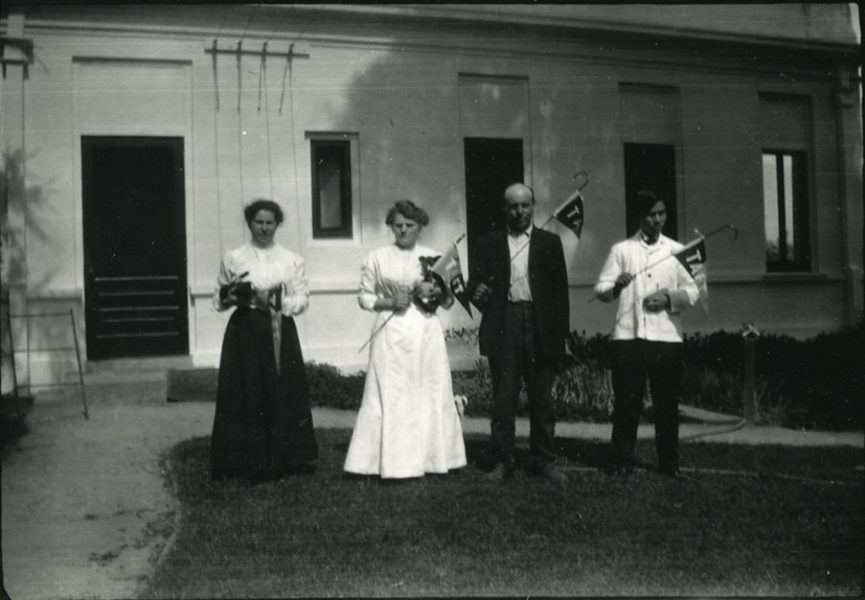 View Winners →
View Winners → Living History: Sheryl Peters and the Fenyes Mansion Servant’s Room

The 1906 Fenyes Mansion, home to Dr. Adalbert Fenyes and the artist Mrs. Eva Fenyes.
—Photo courtesy the Pasadena Museum of History
By Ryan Christopher Coleman
On the 21st of this past May, a door opened in the Fenyes Mansion that had never been opened to the public before. As part of the Museums of the Arroyo (MOTA) annual free admission day, visitors to the Pasadena Museum of History, which is located at the historic Fenyes Estate, were able to visit Fenyes’ Servant’s Room for the first time.
Visitors were greeted by a docent in full Edwardian period costume, in full character as a housekeeper from Fenyes’ heyday in 1910. That docent, the mastermind behind the opening of the Servant’s Room was Sheryl Peters, a museum educator and long-time docent at the Museum of History. Peters practices a kind of education called “living history,” a style of historical re-enactment grounded in extensive research. Living history programs immerse you in history, bringing to life its actors in rich context, rather than merely relaying it to you.
“I needed to find her voice,” Peters says of Agnes Quetu, the subject of her portrayal. Quetu was a long-time servant to the Fenyes family, for many years integral to the daily operations of their lives. But in her research Peters encountered a problem. “I had all this material on Agnes,” she tells me: “letters she wrote, correspondence between others which mentions her, cancelled checks written by her—but I didn’t have her ‘voice.’” Peters is speaking to an intriguing problem which confronts historians—what to do with those whose history wasn’t recorded?
“For a long time we only made brief mentions of the servants on tours,” says Jeannette Bovard, media consultant for the Museum of History. The problem isn’t lack of interest, it’s lack of material. “It’s harder to tell these stories,” Peters explains. “With a woman like Eva Fenyes, we have her journals and sketchbooks, her photographs, her letters and receipts, portraits made of her, and the contents of her home.” It’s much easier to piece together a living portrait of a long-dead person if you have a wealth of well-preserved artifacts.

L to R: Mina Bloch (the cook), William Hutchinson (the gardener) and his wife Katherine, and Joe Hirose (live-in male servant). – Photo courtesy the Pasadena Museum of History
Servants’ lives are harder to reconstruct simply because throughout history the lives of lower-class people weren’t considered worthy of preservation. Many servants couldn’t read, and if they could, they often didn’t write. Often servants’ possessions were used or worn until they were tossed, or they were just tossed anyway.
“You become like a detective,” Peters says of her process, who spent months poring through PMH’s archives while the Servant’s Room was being restored. She gathered material on Agnes, the servant staff at the Fenyes Mansion, as well as the Fenyes family’s previous residence, an elaborate, moorish mansion which once stood at 251 S. Orange Grove. Peters’ Living History performances are special programs for the Museum of History, which means you can’t catch them any time. But her research has been incorporated into regular tours of the Museum, which occur every Friday, Saturday, and Sunday at 12:15pm.
For her efforts, Peters was honored by the Museum of History, distinguished by its board of trustees and a group of her luminary peers at a reception hosted by the Museum on November 29th. Accolades are appreciated, but Peters is already looking forward: more Living History performances, expanded tour territory, perhaps new subjects for portrayal. “For too long we’ve only told the stories of rich, dead, white people,” Peters passionately asserts, “and everyone’s stories deserve to be told.”
The Pasadena Museum of History at the Historic Fenyes Mansion is located at 470 W. Walnut St. For more information on Living History performances, visit the calendar on their website, at www.pasadenahistory.org.





































































































